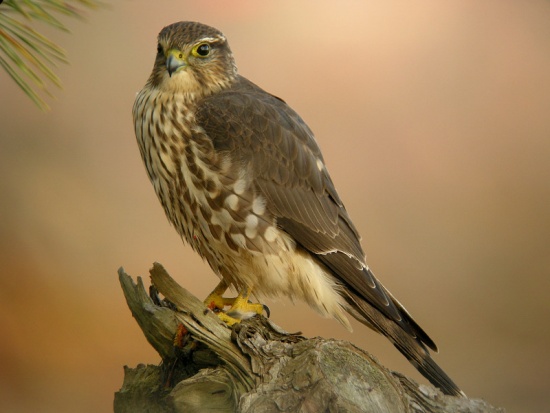(Link) |
|||
| Line 1: | Line 1: | ||
'''Alternative name: Pigeon Hawk''' | '''Alternative name: Pigeon Hawk''' | ||
| − | [[Image:Merlin2.jpg|thumb|550px|right|Photo by {{user|Skean|Skean}}<br />Salisbury, [[Massachusetts]], [[USA]] ]] | + | [[Image:Merlinc.jpg|thumb|550px|right|Photo by {{user|jtwood|jtwood}}<br />Male. Location: East Lothian [[Scotland]]]] |
| + | [[Image:Merlin2.jpg|thumb|550px|right|Photo by {{user|Skean|Skean}}<br />Female. Location: Salisbury, [[Massachusetts]], [[USA]] ]] | ||
;[[:Category:Falco|Falco]] columbarius | ;[[:Category:Falco|Falco]] columbarius | ||
==Identification== | ==Identification== | ||
Revision as of 08:34, 9 August 2010
Alternative name: Pigeon Hawk
- Falco columbarius
Identification
Smallish falcon. Approximately 10-13 inches in length. Pointed wings, less distinguishable facial stripe than most falcons, just a slightly darker slash.
Male
Gunmetal-blue above, with streaked underparts
Female & Immature

The bold markings on the wings and tail showing it to be a juvenile female
Zinc Works Road, Seaton Carew
Brownish, as is juvenile.
Specific populations
Pacific Coast "Black" or "Suckley's" Merlins are very dark, while the "Richardson's" prairie Merlin is noticeably paler than the other subspecies.
Distribution
Generally breeds in the northern hemisphere, with some populations almost resident while others migrate south in winter
From North America there is migration to the Caribbean, Central America, and northern South America, while European birds migrate to southern Europe and Africa north of Sahara. Also occurs in northern Asia.
Breeds over most of Alaska and Canada south of the tree-line and in the north-west and north-central USA. Winters from south-west Canada, the western and southern USA south through Mexico to Panama, in the West Indies and the northern coast of South America. Vagrant south to Bahia, Brazil.
In Europe breeds in Iceland and the Faroes, throughout northern Scandinavia, sporadically in the Baltic States and widespread across northern Russia. Also very patchily in the uplands of the north and west British Isles although now extremely rare in south-west England. Dispersive in south-west Iceland and the British Isles, but elsewhere a summer visitor. Autumn movements take place mainly in September-October with the spring return in April-May. Winters in coastal Britain, Denmark and southern Sweden south to the Mediterranean, on some of the larger islands and in North Africa. Recorded as a vagrant north to Svalbard and south to Madeira and the Canary Islands.
Occurs across northern Asia from the Urals east to the Pacific coast of Russia and Sakhalin and ranges south to the Tien Shan Mountains in Central Asia. Winters from the Middle East to the Himalayas, northern Indochina, China and Japan. A vagrant to Oman and Yemen.
Taxonomy
Eight races are usually recognised:
columbarius, the Taiga Merlin, in Alaska and northern Canada
suckleyi from British Columbia to northern California
richardsonii in the Great Plains.
The large and dark F.c.subaesalon breeds in Iceland and the Faroes and winters in the British Isles, rarely on European coasts from Norway to France
aesalon breeds from Europe to western Siberia
the paler insignis breeds in eastern Siberia and winters in Japan and China.
Another pale race pallidus breeds in west-central Asia
lymani in the eastern Altai, Tien Shan and western China.
There have been proposals to split the North American group from the European group, as they have more than 2% sequence divergence.
Habitat
Breeds on moorland and heaths, tundra and boreal forest-edge. In winter on coastal farmland, marshes and other open habitats.
Behaviour
Especially the American Merlins are known for their aggressive behavior, even during migration going out of their way to mob larger birds of prey.
Diet
The most important food is small birds which are generally caught in flight.
Vocalisation
<flashmp3>Falco columbarius (song).mp3</flashmp3>
Listen in an external program
References
Wink et al. Molecular systematics of holarctic raptors (Order Falconiformes). In: Chancellor et al. (eds.): Holarctic Birds of Prey: 29-48. http://www.uni-heidelberg.de/institute/fak14/ipmb/phazb/pubwink/1998/31.%201998.pdf
External Links





